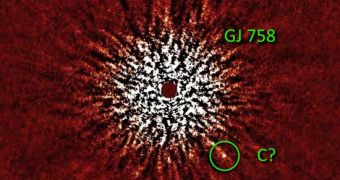The international astronomical community is buzzing with excitement, following the announcement that the first observations of a planet-like object around its parent star have been made. The newly imaged bodies, which are known as GJ 758 B, and possibly GJ 758 C, orbit a Sun-like star located approximately 50 light-years away from our solar system. The planet was photographed using the Hawaii-based Subaru Telescope's new adaptive optics instrument, which allowed for the observatory to correct the distortions created by the Earth's atmosphere, Space reports.
The picture was taken with the High-Contrast Coronagraphic Imager for Adaptive Optics (HiCIAO) instrument on the Subaru, which is apparently very well suited for this type of astronomical observations. Such a finding is not new. Experts discovered and imaged similar systems in the past. Last year, for instance, a similar formation was observed, but it featured very large planets, orbiting around a star several times the mass of our Sun. The new investigation has revealed a system that looks pretty much like our own does, which is why everyone is so excited.
According to Michael McElwain, a Princeton University-based study team member, the parent star in the system, GJ 758, is roughly the same size and mass as our Sun, which means that the exoplanet is about the size of Jupiter. The images may have revealed two exoplanets, but astronomers are still working on the data, and have yet to come up with a clear conclusion. The team is also still assessing the possibility that the exoplanet may in fact be a brown dwarf, a celestial body that astronomers sometimes refer to as a “failed star.” These objects are thought to have experienced some obstacles in their paths of becoming full-fledged stars, which terminated their evolution.
“Brown dwarf companions to solar-type stars are extremely rare. It's exciting to find something that is so cool and so low mass with a separation similar to our solar system around a nearby star,” McElwain says. “This challenging but beautiful detection of a very low mass companion to a Sun-like star reminds us again how little we truly know about the census of gas giant planets and brown dwarfs around nearby stars. Observations like this will enable theorists to begin to make sense of how this hitherto unseen population of bodies was able to form and evolve,” Carnegie Institution for Science astronomer Alan Boss, who was not a part of the new study, adds.

 14 DAY TRIAL //
14 DAY TRIAL //